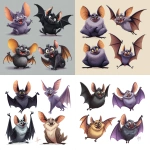Explore the Best AI Image Gallery

5G Technology: Shaping the Creative Landscape of Tomorrow
As the world moves deeper into the digital age, 5G technology is emerging as a transformative force, promising to redefine countless industries, particularly the creative sector. This fifth generation of mobile networks is characterized by lightning-fast internet speeds, ultra-reliable low latency, and the capacity to connect a myriad of devices simultaneously. But beyond its technical specifications, 5G holds the potential to unleash creativity and innovation across various fields, from art and music to film and gaming. In this blog post, we explore the multifaceted impact of 5G on the creative industry, delve into potential uses, consider ethical implications, and speculate on future trends.
Transformative Impact on Creative Industries
The creative industry thrives on collaboration, flexibility, and real-time interaction. 5G allows for seamless sharing of high-resolution content, encouraging artists and creators to collaborate regardless of geographical boundaries. For instance, musicians can facilitate live performances across continents with minimal delay, while filmmakers can stream high-definition footage directly to their audiences without interruptions.
1. Digital Art and Augmented Reality
One of the most exciting potentials of 5G lies in its impact on digital art and augmented reality (AR). Artists can create immersive experiences by integrating AR into their work, allowing audiences to engage with art pieces in a more interactive way. Imagine walking through an art gallery where every artwork comes to life with animations and sounds, all powered by a 5G connection. This synergy between 5G and digital art not only enhances the experience for the viewer but also opens new avenues for artists to express their creativity.
2. Streaming Services and Distribution
The rise of streaming services has already revolutionized how creatives reach their audiences. With 5G, content distribution will become even faster and more efficient. Creators will be able to upload and share content in high quality without worrying about buffering or connection issues. With this improved infrastructure, artists from various fields—be it musicians, filmmakers, or game developers—can get their work into the hands of audiences more readily, breaking down traditional barriers in the distribution process.
Potential Uses of 5G in Creative Industries
Beyond streaming and AR, the uses of 5G in the creative economy are vast and varied. Some potential applications include:
- Collaborative Creation: Tools and platforms designed for joint projects can function in real-time, regardless of where the creatives are located.
- Remote Production: Filmmakers and artists can leverage 5G to direct shoots or sessions remotely while receiving live feedback.
- Enhanced Live Events: Concerts and performance art can incorporate interactive elements, enabling viewers to interact and engage with the performance through their devices.
- IoT-Enabled Creations: Internet of Things (IoT) devices linked via 5G can enable artists to create installations that respond to visitor interaction.
Ethical Considerations
With every technological leap come ethical questions. The deployment of 5G not only refers to speed and connectivity but also the implications of increased surveillance capabilities and data usage. As creative industries become more data-driven, issues surrounding privacy and consent arise. For instance, artists may inadvertently collect user data during interactive installations or performances. It's essential to establish guidelines to ensure that ethical standards are maintained.
Moreover, the potential for inequality in access to these technologies cannot be ignored. As 5G is rolled out, disparities may grow between those who have access to this technology and those who do not, potentially leading to a digital divide in the creative sector.
Future Trends in Creative Industries with 5G
Looking ahead, the ongoing evolution of 5G technology will likely spur significant innovations in the creative landscape. Here are some trends to watch:
- Increased Use of AI: The synergy between 5G and artificial intelligence is poised to redefine how we approach creative processes, enabling smarter tools and analytics that support artists.
- Greater Personalization: Enhanced data analytics powered by 5G will allow for tailored content experiences, where users can receive personalized recommendations and interactions.
- Expansion of Virtual Reality (VR): Enhanced bandwidth will aid in facilitating more sophisticated VR experiences in gaming, storytelling, and interactive installations.
- New Business Models: The creative economy may see the emergence of subscription services and crowdfunding platforms, allowing creators to monetize their work directly with audiences.
In conclusion, 5G technology is more than just a new mobile network; it represents a canvas of possibilities for the creative industry. As innovative uses continue to unfold, ethical considerations remains at the forefront, ensuring that creativity can flourish in an equitable and responsible manner. The journey ahead is undoubtedly exciting, and we can only anticipate the remarkable projects and advancements it will inspire.



](https://images.ai-img.art/thumbnails/150/485c8b1c747827bdc9a962f8a1919b3c259b18dd263b260208a1eae19fb85e07.webp)








](https://images.ai-img.art/thumbnails/150/5197af8969d850e2a43e141d41e482ccbceedebceb2a4caf9f098f943f9d1b0f.webp)
](https://images.ai-img.art/thumbnails/150/3020b8c2b6d9be07e042357107af1de10deb274a41d2b0f332684ad4b532a702.webp)


](https://images.ai-img.art/thumbnails/150/2fbd98ecfc425cfc1597779121e1c0305437067779e9c471eb64ff9615d5be98.webp)









](https://images.ai-img.art/thumbnails/150/269414b0e541026702e9e67c67602c96162f37ff460a388b3b36314c8fc936dd.webp)















](https://images.ai-img.art/thumbnails/150/8d1fe5a7a49cfc96747182431a853357913286d89258383caab2d3b4681afcb5.webp)






